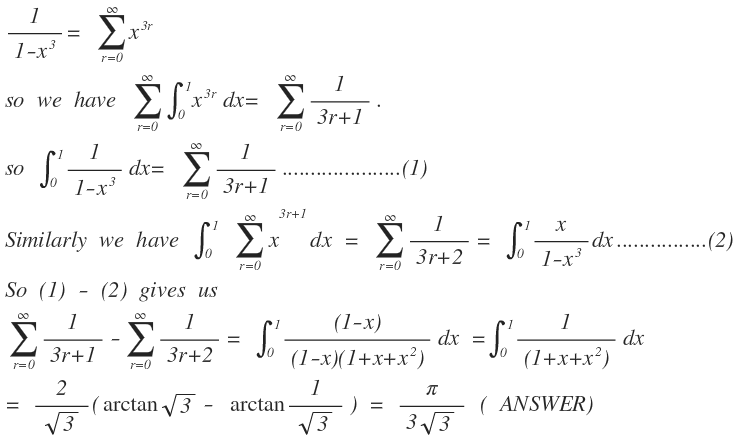Is it a telescopic series?
n → ∞ lim r = 0 ∑ n ( 3 r + 1 1 − 3 r + 2 1 ) = ?
The answer is 0.604.
This section requires Javascript.
You are seeing this because something didn't load right. We suggest you, (a) try
refreshing the page, (b) enabling javascript if it is disabled on your browser and,
finally, (c)
loading the
non-javascript version of this page
. We're sorry about the hassle.
6 solutions
Or, this summation is equivalent to ∫ 0 1 r = 0 ∑ ∞ x 3 r − x 3 r + 1 d x = ∫ 0 1 1 − x 3 1 − x d x = 1 + x 2 + x 1 d x = 3 3 π
Log in to reply
Oh! Yes Sorry, I missed this thing, I should notice this too.
nice approach
Wonderful!
Did the same! :)
that is the best approach!!
To make the double integral easier we can us a neat property of double integrals of reversing the order of integration. That is , S = 0 ∫ 1 0 ∫ x 1 − y 3 1 d y d x = 0 ∫ 1 y ∫ 1 1 − y 3 1 d x d y .
So first simply integrate out x since it is independent of y to obtain a familiar integral of the form quadratic 1 .
By the way, nice solution Ronak. +1 for it.
It would be good to argue why the interchange is valid.
can we use riemann sum...
Can you please give a hint on how to integrate (dx/1+x^(3)) ?
L = r = 0 ∑ ∞ ( 3 r + 1 1 − 3 r + 2 1 ) = 1 − 2 1 + 4 1 − 5 1 + 7 1 − 8 1 + . . .
Now consider the Maclaurin series of − ln ( 1 − z ) , where z is a complex number:
− ln ( 1 − z ) − ln ( 1 − e 3 2 π i ) ℑ [ − ln ( 1 − e 3 2 π i ) ] ℑ [ − ln ( 1 + 2 1 − 2 3 i ) ] ℑ [ − ln ( 2 3 − 2 3 i ) ] ℑ [ − ln ( 3 ( 2 3 − 2 1 i ) ) ] ⟹ L = z + 2 z 2 + 3 z 3 + 4 z 4 + 5 z 5 + 6 z 6 + . . . Let z = e 3 2 π i = e 3 2 π i + 2 e 3 4 π i + 3 e 2 π i + 4 e 3 8 π i + 5 e 3 1 0 π i + 6 e 4 π i + . . . Taking the imaginary part both sides = sin 3 2 π + 2 sin 3 4 π + 3 sin 2 π + 4 sin 3 8 π + 5 sin 3 1 0 π + 6 sin 4 π + . . . Note that − 1 < sin 3 2 k π < 1 = 2 3 − 2 3 ⋅ 2 1 + 3 0 + 2 3 ⋅ 4 1 − 2 3 ⋅ 5 1 + 6 0 + . . . = 2 3 ( 1 − 2 1 + 4 1 − 5 1 + 7 1 − 8 1 + . . . ) = 2 3 ⋅ L = 3 2 ⋅ ℑ [ − ln ( 3 e − 6 π i ) ] = 3 2 ⋅ ℑ [ − ln 3 + 6 π i ] = 3 3 π ≈ 0 . 6 0 5
Any one here used a python code? :D
Got 0.604598676967
I used calculator after 40-50 terms sum almost do not change hence the answer comes.
The easiest way is to mention few terms: 1 1 - 2 1 + 4 1 - 5 1 + 7 1 - 8 1 ...etc. We notice, we are summing over (0,1) the following integral ∫ 1 − x 3 1 − x = 3 3 π
http://scipp.ucsc.edu/~haber/ph116A/powertheorems.pdf

Question is easy if you know the concept of interchanging summations and integrals.First we write the required sum as :
S = r = 0 ∑ ∞ ( 3 r + 1 ) ( 3 r + 2 ) 1
We know that :
∫ 0 x y 3 r d y = 3 r + 1 x 3 r + 1
Integrating it again with respect to x and putting limits 0 to 1 we get :
∫ 0 1 ∫ 0 x y 3 r d y d x = ∫ 0 1 3 r + 1 x 3 r + 1 d x = ( 3 r + 1 ) ( 3 r + 2 ) 1
So in the expression of S we replace our general term with our integration expression to get :
S = r = 0 ∑ ∞ ∫ 0 1 ∫ 0 x y 3 r d y d x
Here comes the main trick what we do now is interchange integral and the summation to get :
S = ∫ 0 1 ∫ 0 x r = 1 ∑ ∞ y 3 r d y d x
After interchanging we see that our summation has now become an infinite G.P. hence applying the formula for infinte G.P we get :
S = ∫ 0 1 ∫ 0 x 1 − y 3 1 d y d x
Now the thing left is a not so simple double integral which can be evaluated with good amount of hard work and it comes out to be :
S = 3 3 π